We’re both amateur cyclists that enjoy a good ride once in a while. While cycling not only that you have more time to admire the surroundings, but you also get a feeling of your surroundings. It is an experience hard to explain to those who never cycled, and if you have never cycled, maybe this article is not for you. We covered a distance of 45 km (28 miles) in one day with an elevation gain of 320m (1000 feet) and took a well-deserved lunch break and short rest. We also ventured on some sandy paths just for fun.
Where to Rent Bicycles
As with most things in Cuba: talk with your host to have it arranged. We talked the day before our cycling adventure, and the bicycles were delivered to our door in the morning. We did a test ride, settled that everything was okay, and the person with the bikes gave us a business card to call him in case we encountered any problems, and off we went.
When we got back late in the evening, we didn’t have to bother returning the bikes. We just let them in front of the door for pick-up.

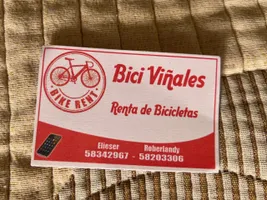
They were not the best and newest bikes, but what can you expect in Cuba? In fact, they exceeded my expectations by far. We had absolutely no issues with them and they rode very well.
Viñales Cycling Itinerary
Here’s just a short list of the main attractions ordered from the first visit to the last one. We’re going to go into details about each point, but first, let’s take a look at the maps.
- Mirador del Valle de Viñales & Mirador Los Jazmines
- Valle de Dos Hermanas & Mural de la Prehistoria
- Cueva del Indio
- Palenque de los Cimarrones & Cueva de San Miguel
- Extra: Cueva del Palmarito
- Extra: Trails near Viñales
- Extra: Presa el Salto Lake

The map above includes the most important attractions and activities in Viñales, including the cycling route. You can explore the map in more detail if you click on it, and even create your own copy on Google MyMaps.
To be honest, we overestimated a bit how maps and orientation work in Cuba. We didn’t get lost at any point in our cycling adventure, but we had times when uncertainty prevented us from accomplishing our initial plans. We adapted and learned from our experience. This helped us create a better itinerary for cycling in Viñales.
There are 3 main routes that we wanted to cycle on, and an additional one that we heard of from locals: the Blue, Red, Yellow, and Green. Our plan was to connect all of them (except Green) together into a single route, like on the right-hand side map.


- The Blue route: Viñales - Mirador del Valle de Viñales & Mirador Los Jazmines - Viñales
- The Red route: Viñales - Valle de Dos Hermanas & Mural de la Prehistoria - Cueva del Palmarito - Trails near Viñales (El Corazón del Valle) - Viñales
- The Yellow route: Viñales - Cueva del Indio - Palenque de los Cimarrones & Cueva de San Miguel - Viñales
- The Green route: Viñales - Presa el Salto Lake - Viñales
What we ended up actually cycling is the map below on the left-hand side. With the experience we now have, we would recommend the map below on the right-hand side. This is the same route as the main map above from Google Maps, but without Cueva del Palmarito, and with some additional trails in Viñales. This route is also included in a special layer in the Google Maps that we created for Cuba.


The map above captures the most important attractions on the cycling route. After you finish this, you can check out other places if you still have some stamina left. Cueva del Palmarito should be considered more like an addition than a must-see. Also, if you feel adventurous, you can venture on some trails close to Viñales. Head to the Cueva de la Vaca Trailhead (marked on the Cuba by Travelfoss Google Map), and turn right once you reach the trail sign. This path heads towards El Corazón del Valle, however, the point is not to get there but rather to have some fun on sandy trails. Still feeling adventurous? You can even pedal to Presa El Salto Lake.
Exploring Parque Nacional Viñales
Parque Nacional Viñales covers a large area around Viñales, and the Valley of Viñales (Valle de Viñales in Spanish) is a UNESCO World Heritage Site.

Mirador del Valle de Viñales & Mirador Los Jazmines
Our first stop on our cycling adventure was a scenic spot called Mirador del Valle de Viñales. This place offers one of the best views of the entire Valley of Viñales. It’s a bit of uphill pedaling to get here, but not too much. After all, the elevation gain is what makes it a great vista point, and probably the only one.
For the best light, it is better to visit this place very early in the morning (at sunrise if you can) or at sunset. We’re not early birds, and we couldn’t make it that early, but the light is good in the morning anyway. We didn’t want to come here at sunset, because it meant that we had to ride back in the darkness of the night. Old cars have poor headlamps, so riding a bike during the night was off our list.
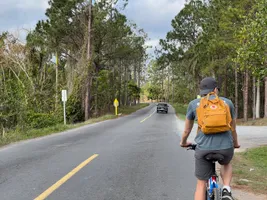

There’s a big hotel in the area called Hotel Horizontes Los Jazmines, and a few restaurants as well. You can stop for a coffee or refreshment break, or you can just sit there and admire the views.
Valle De Dos Hermanas & Mural de la Prehistoria
From Mirador del Valle de Viñales we wanted to make a loop and reach Valle de Dos Hermanas where Mural de la Prehistoria is located. While the road to do this loop was clearly visible on Google Maps, you couldn’t tell how bad it was. The road got rougher and rougher up to the point where it turned into an uphill, dirt road which was quite hard to pedal on.


We didn’t want to risk wasting so much energy and not knowing for sure that the road was passable until the end. There was also not much to see in this area, so we decided to turn back and ride on the main roads.
The landscapes were breathtaking, and the asphalt road with very few cars made cycling a breeze. Valle de Dos Hermanas is a real beauty, and I would love to pedal there again. The valley is situated between Mogote del Valle and Mogote de Dos Hermanos on which the mural is painted. It was such a joy and pleasure to ride this scenic route. A place you should not miss if you want to create unforgettable memories on your bike ride in Viñales.


Mural de la Prehistoria (The Mural of The Prehistory) is a large painting on one of the mogotes in Valle de Dos Hermanas. They claim that it is one of the largest murals in the world, and indeed it was big.


The theme of the mural is the evolution of life in Cuba, including a geological perspective, with fossils, and a biological one referring to aboriginal settlements.
Cueva del Palmarito & Trails near Viñales
From Valle de Dos Hermanas it is possible to reach Viñales on a different path than the main road, making a loop around Mogote del Valle, through El Corazón del Valle. This path also passes Cueva del Palmarito. However, this trail is not marked on any map, and I assume that is known only by locals. I am not even sure if this trail is suitable for bikes, or just horses. With our bicycles, we stuck to the known roads and therefore skipped Cueva del Palmarito. If you are interested in exploring this area of the valley that connects Valle de Dos Hermanas with Cueva del Palmarito and Viñales then you should hire a guide and go for a horseback ride adventure.
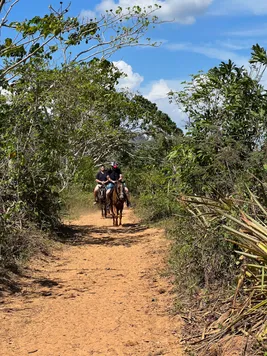

Once we got back in Viñales we went to check out where this horseback ride would start. I believe it is right next to the signpost where the trail to Cueva de la Vaca starts. It is here where we’ve seen horses, locals inviting us for a ride, and tourists horseback riding on deep sandy trails. We ventured on the trails with our bikes trying to reach Cueva del Palmarito, but the sand was so deep and the trails so confusing that we turned back. It was a good opportunity though to stop for a cold, refreshing coconut. We also had lunch in Viñales to replenish our energy levels.


There is one more road on the map that could lead to Cueva del Palmarito, but we decided to skip it in order to explore more parts of the Viñales National Park.
Palenque de los Cimarrones & Cueva de San Miguel
Pedaling North of Viñales you will explore more mogotes, valleys, and caves. The breathtaking landscapes of the Viñales National Park never cease to impress. Our next stop is between 2 other impressive mogotes that will leave you speechless. You’re now pedaling a bit downhill, so don’t forget that you will have to go up on the way back.
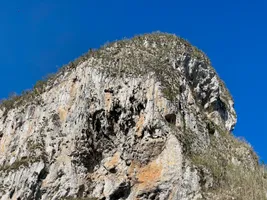

Palenque de los Cimarrones and Cueva de San Miguel were a bit unexpected. There’s a restaurant and a bar inside the cave, and even the toilets are inside the cave. This is probably the first and last time we’ll be posting photos with toilets, but you have to admit that this is really unique.


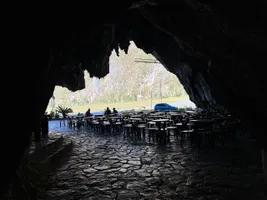
There’s also a cave system that you can explore, one that is officially maintained. The entrance is close to the bar, and the exit is somewhere else, through the mogote. The place is quite nice, maintained, and surrounded by banana and tobacco plantations.



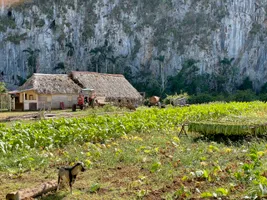
Cueva del Indio
Moving further we reach our last stop: Cueva del Indio. This is one of the most spectacular caves in Viñales. It features walking trails and an underground river that you can navigate by boat. I believe this cave to be very impressive, and our host insisted that we should visit it.
Unfortunately, we got there a bit late, but not too late for a visit. However, there were some people in the parking lot, apparently working there, who told us that we were too late, but if we had “large pockets” then we could go. With our beginner Spanish and their coded speech, we didn’t really understand at that moment that they just wanted us to pay them something extra. We left a bit upset, and I believe they regretted not letting us in when they saw we left. They shouted after us to go and visit the cave that it is open, but we had to leave our bikes there, untied, in an empty parking lot, with 2 strangers. The cave is 5.5km away from Viñales. Although theft from tourists is not common in Cuba, losing our bikes was not a risk that we were willing to take.

What we’ve done wrong is leaving this cave the last thing during the cycling day trip. Every other place that we visited was looming with people, tourists, and locals alike. We should have at least pedaled all the way from Viñales to Cueva del Indio, and leave Palenque de los Cimarrones & Cueva de San Miguel at the end. We also pedaled for about an hour on the sandy trails near Viñales which we could have left as the last thing in the day. This experience helped us develop a better itinerary for your Viñales cycling adventure.
Presa El Salto Lake
The guide we had in Valle del Silencio told us that the Presa El Salto Lake is very nice and tranquil. It is a great spot to relax and even take a bath on a hot day, especially after biking. However, our schedule was too tight and we didn’t manage to get to it.
The season of the year when you’re visiting Viñales matters a lot. The lake levels vary much between the wet and the dry season. If you are there towards the end of the dry season, chances are that the lake won’t be too impressive or worth visiting at all.
Cycling Safety
We don’t recommend anyone to venture too far away on dirt paths on their own. Sticking to roads that appear on Google Maps is mostly safe if you have a map, GPS, or other means of orientation with you, as you would normally do while traveling anywhere else. However, dirt paths meandering through agricultural fields, pastures, and mogotes are not recommended without a guide. Cuba is frequently hit by hurricanes which can destroy these small paths. The paths get redone by locals who need to get from one place to another. This doesn’t guarantee that the paths will be exactly the same as on your map leading to disorientation.
Our host in Viñales had 2 guests before us who got lost in the mogotes with their bikes while trying to follow paths that no longer exist. Those tourists were able to phone call the host and get help. Everything was fine in the end, but it was a terrifying experience for the couple.
Back to Viñales
It’s now time to head back to your accommodation, have a refreshing shower, and enjoy dinner. There’s no better dinner than a traditional local meal cooked by your hosts. If you have one more day to spend in Viñales, then you can discover more ideas of things to do from our broad list of suggestions.
 Travelfoss
Travelfoss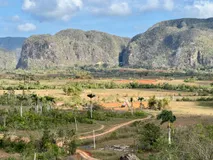
Biking Cuba Tour
It is possible to cycle the entire island of Cuba. I am sure it is a unique way to explore this country. While we were interested in this kind of adventure, we were also a bit skeptical because we feared biking on the streets. Now, after exploring the island by car from Viñales to Trinidad, and after biking 45km (28 miles) around Viñales, we changed our minds completely. Cuba is probably the safest country to embark on such a long cycling adventure because its roads are mostly empty.
If you are looking for a group to tag along and have your luggage carried for you while you bike, then our favorite small group travel company is G Adventure, and it is our go-to option for destinations where we prefer to be with a guide that handles everything for us.
Related Travel Articles
- What You Should Know Before Traveling to Cuba
- Top things to do in Viñales, Cuba: Activities and Experiences You Can't Miss
- Traveling to Viñales: What You Need to Know Before You Go
- Valle el Silencio: Hiking, Horseback Riding, Tobacco, Rum, and More
- Viñales on Foot: A Tranquil Guide to Exploring the Cuban Countryside

Writing free, independent and personal travel content since 2021. If you appreciate what we do, then you can return the favor by using the affiliate links below.
- Get your accommodations on Booking.com
- Buy your gear and gadgets from Amazon
- Book flights using Expedia
- Book activities on Get Your Guide
- Book guided trips on G Adventures

Writing free, independent and personal travel content since 2021. If you appreciate what we do, then you can return the favor by using the affiliate links below with no cost for you.
